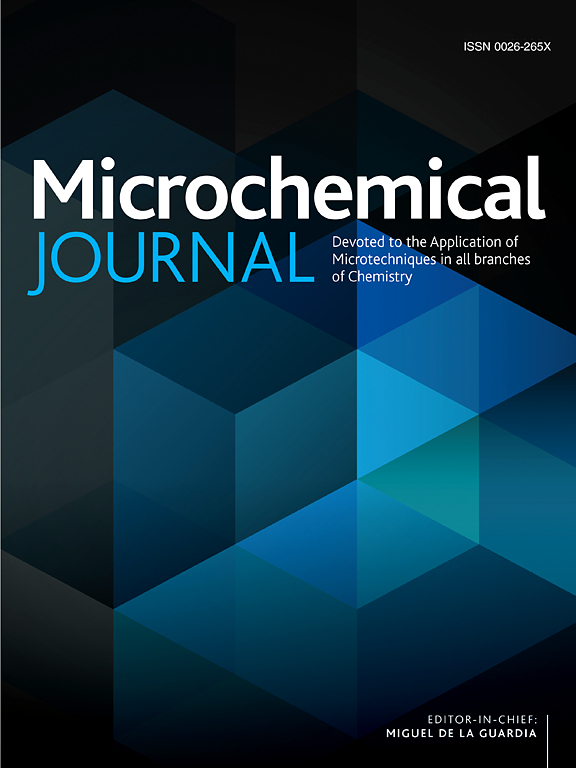可重复使用和原位电沉积SPE-PB-Ag底物:推进EC-SERS高效检测水果和蔬菜中的啶虫脒
IF 4.9
2区 化学
Q1 CHEMISTRY, ANALYTICAL
引用次数: 0
摘要
在农业领域,农药,特别是新烟碱类醋氨虫(AAP)的扩散引起了人们对食品残留的关注,这与公共健康和安全有关。为了解决这一问题,我们开发了一种高通量的检测方法——电化学表面增强拉曼光谱(EC-SERS),可以快速灵敏地检测水果和蔬菜中的AAP。我们的方法包括通过原位电沉积工艺创建新的无标签底物SPE-PB-Ag,该工艺直接适用于EC-SERS中农药残留的检测。该衬底在−0.6 V电位下具有0.1 μM ~ 100 μM的宽线性检测范围,低检测限(LOD)为0.038 μM,是传统SERS方法(LOD为0.366 μM)的10倍。所使用的电位有效地调节了AAP分子与底物表面之间稳定的物理吸附相互作用,从而优化了EC-SERS检测过程。此外,SPE-PB-Ag EC-SERS衬底显示出通过纯水简单洗涤即可再生的能力,从而在多次使用中保持其高增强效果。因此,本研究提出了一种创新、方便、快速、可靠的果蔬农药残留检测策略,将推动食品安全和环境监测领域的发展。本文章由计算机程序翻译,如有差异,请以英文原文为准。
Reusable and In-Situ Electrodeposited SPE-PB-Ag Substrate: Advancing EC-SERS for efficient acetamiprid detection in fruits and vegetables
In agriculture, the spread of pesticides, especially neonicotinoid acetamiprid (AAP), has raised concerns about food residues which are of relevance to public health and safety. To solve this problem, we have developed a high-throughput detection method, electrochemical surface-enhanced Raman Spectroscopy (EC-SERS), which can detect AAP quickly and sensitively in fruit and vegetables. Our method involves the creation of a new label-free substrate, SPE-PB-Ag, by means of an in situ electrodeposition process that is directly applicable to the detection of pesticide residues in EC-SERS. This substrate demonstrated a broad linear range of detection from 0.1 μM to 100 μM at a potential of −0.6 V and a low limit of detection (LOD) of 0.038 μM, which is 10-fold higher than the conventional SERS method (LOD, 0.366 μM). The potential used effectively modulated the stable physical adsorption interactions between the AAP molecules and the substrate surface, thus optimising the EC-SERS detection process. Moreover, the SPE-PB-Ag EC-SERS substrate exhibits the ability to be regenerated through simple washing with pure water, thus sustaining its high enhancement effect over multiple uses. Therefore, this study presents an innovative, convenient, rapid, and reliable strategy for the detection of pesticide residues in fruits and vegetables, advancing the field of food safety and environmental monitoring.
求助全文
通过发布文献求助,成功后即可免费获取论文全文。
去求助
来源期刊

Microchemical Journal
化学-分析化学
CiteScore
8.70
自引率
8.30%
发文量
1131
审稿时长
1.9 months
期刊介绍:
The Microchemical Journal is a peer reviewed journal devoted to all aspects and phases of analytical chemistry and chemical analysis. The Microchemical Journal publishes articles which are at the forefront of modern analytical chemistry and cover innovations in the techniques to the finest possible limits. This includes fundamental aspects, instrumentation, new developments, innovative and novel methods and applications including environmental and clinical field.
Traditional classical analytical methods such as spectrophotometry and titrimetry as well as established instrumentation methods such as flame and graphite furnace atomic absorption spectrometry, gas chromatography, and modified glassy or carbon electrode electrochemical methods will be considered, provided they show significant improvements and novelty compared to the established methods.
 求助内容:
求助内容: 应助结果提醒方式:
应助结果提醒方式:


